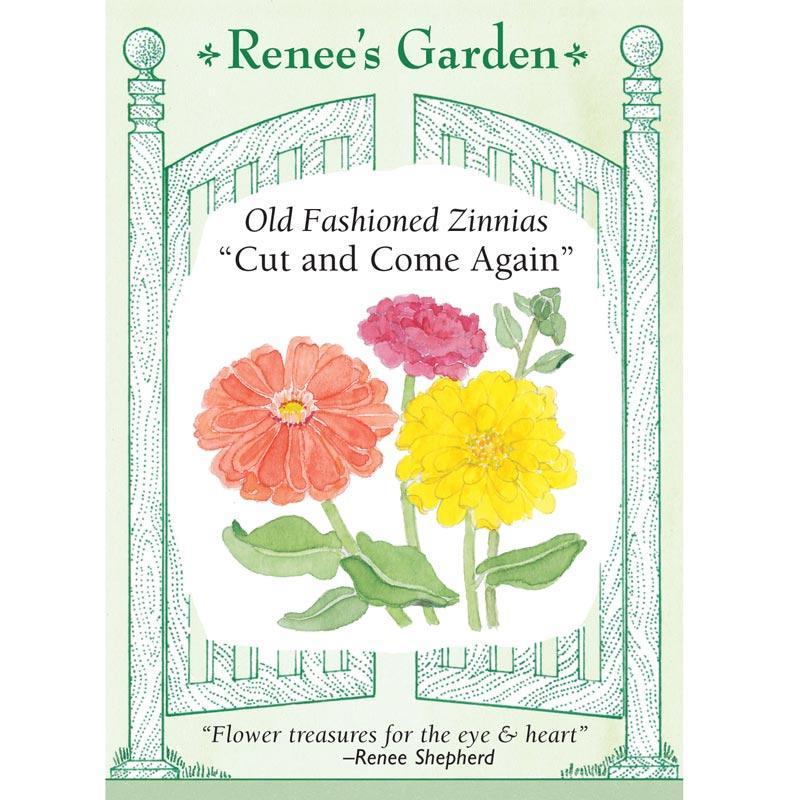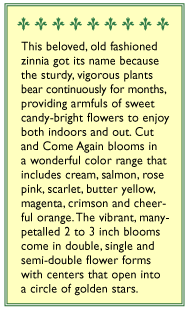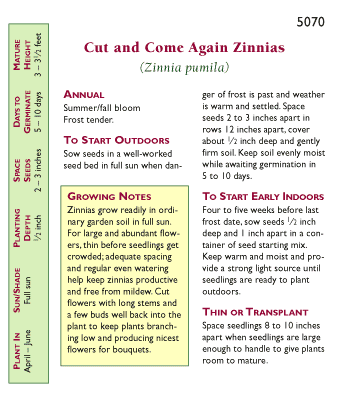Item Number: SWF5070
Old Fashioned Cut & Come Again Zinnia Flower Seeds
Wide Ranging Colors and Forms
Zinnia - Cut and Come Again (Heirloom) - Zinnia pumila
Annual - This beloved, old-fashioned zinnia got its name because the sturdy, vigorous plants bear continuously for months, providing armfuls of sweet, candy-bright flowers to enjoy both indoors and out. Cut and Come Again blooms in a wonderful color range that includes cream, salmon, rose, pink, scarlet, butter yellow, magenta, crimson and cheerful orange. The vibrant, many-petalled 2 - 3" blooms come in double, single and semi-double flower forms with centers that open into a circle of golden stars.
Soil & Water: Zinnias grow readily in ordinary garden soil in full sun. For large and abundant flowers, thin before seedlings get crowded; adequate spacing and regular, even watering helps keep zinnias productive and discourages mildew. Pick when flower blossoms first open and petals are tight for longest vase life. Cut long stems well back into the plant to keep plants branching low and producing best blooms.
Planting & Growing:To Start Directly in the Garden: Sow seeds in a well-worked seedbed in full sun when the danger of frost has passed and weather is above 50°F both day and night. Space seeds 2-3”, cover about 1/2” and gently firm soil. Keep evenly moist while awaiting germination. Thin seedlings to 8 - 10” apart when large enough to handle. To Start Early Indoors: Four weeks before the last frost date, sow seeds 1/2” deep and 2-3” apart in containers of seed starting mix. Keep warm and moist and provide a strong light source. Feed with half-strength fertilizer every 2 weeks. Just as soon as seedlings have several sets of true leaves, and weather is above 50°F both day and night, transplant outdoors about 8 - 10” apart.
Soil Temperature: above 50°F
Planting Depth: 1/2"
Germination: 5-10 Days
Height At Maturity: 3 to 3-1/2 feet
Sun/Shade: Full Sun
Spacing After Thinning: 8-10"
Approx Seeds per Pack: 135 Seeds
Zinnia Cut and Come Again seeds offer a delightful addition to any garden, providing an abundance of colorful, vibrant blooms that can be enjoyed throughout the growing season.
The Charm of Zinnia Cut and Come Again
Zinnias are well-known for their stunning, daisy-like flowers that come in a wide range of colors, from brilliant reds to soft pinks and sunny yellows. The "Cut and Come Again" variety, in particular, has a unique feature that makes it a favorite among gardeners. As the name suggests, these zinnias can be repeatedly cut for floral arrangements, and they will continue to produce new blossoms throughout the season.
Characteristics of Zinnia Cut and Come Again
Colorful Blooms: One of the most captivating aspects of these zinnias is their vibrant and diverse color palette. From deep purples to pastel shades, these flowers add a burst of color to any garden.
Long Blooming Period: The "Cut and Come Again" variety lives up to its name. Once you start cutting its blossoms for bouquets or arrangements, it responds by producing new blooms continuously, ensuring a colorful garden all season long.
Easy to Grow: Zinnias are known for their ease of cultivation, making them an excellent choice for both experienced gardeners and beginners. They thrive in well-drained soil and full sunlight, requiring minimal maintenance.
Attracting Pollinators: Zinnias are also renowned for their ability to attract pollinators like butterflies and bees. By planting these flowers, you can contribute to the health of your local ecosystem.
Cultivating Zinnia Cut and Come Again Seeds
Cultivating Zinnia Cut and Come Again seeds is a rewarding experience that allows you to enjoy the beauty of these flowers from the comfort of your own garden. Here's how you can get started:
Seed Selection: Begin by selecting high-quality Zinnia Cut and Come Again seeds. This will increase the likelihood of successful germination.
Planting: Choose a suitable location in your garden that receives full sun. Zinnias thrive in well-drained soil, so make sure the soil is loose and not waterlogged. Plant the seeds about 1/4 inch deep and spaced apart according to the recommended guidelines on the seed packet.
Watering: Keep the soil consistently moist but avoid overwatering, as zinnias are susceptible to root rot. Water at the base of the plants to prevent fungal diseases.
Maintenance: Zinnias are generally low-maintenance, but deadheading (removing spent blossoms) can encourage more blooms. Fertilize sparingly, as too much fertilizer can lead to excessive foliage growth at the expense of flowers.
Harvesting: When your zinnias are in bloom, you can start cutting them for floral arrangements. Use clean, sharp scissors or shears, and cut the stems just above a set of leaves. This encourages new growth and more flowers.
Zinnia Cut and Come Again seeds bring a touch of natural beauty to any garden, offering a constant supply of colorful blossoms that can be enjoyed throughout the growing season. With their easy cultivation and ability to attract pollinators, these zinnias are a delightful addition to both novice and experienced gardeners alike. Whether you are seeking to enhance your garden's aesthetics or create stunning floral arrangements, Zinnia Cut and Come Again seeds are sure to add a splash of color and joy to your gardening endeavors.
Check Your Zone Compatibility:
Compatible with your zone.
Growing Zone for

Our Guarantee To You
Since 1976, we've served our customers at every stage of growing. Please contact us at any time. We are happy to support and assist you.
Shipping Information
Shipping Information
Shipping Weight: 0.01 lb
Dimensions: 4.5"L x 3.125"W x 0.1"H
Features
Features
- Attracts Bees/Butterflies
- Does Not Require Support
- Good Cut Flower
- Good Fall Color
- Heirloom
- Requires Summer Water
- Useful for Ornamental
Characteristics
Characteristics
Planting & Care
Planting & Care
Soil & Water: Zinnias grow readily in ordinary garden soil in full sun. For large and abundant flowers, thin before seedlings get crowded; adequate spacing and regular, even watering helps keep zinnias productive and discourages mildew. Pick when flower blossoms first open and petals are tight for longest vase life. Cut long stems well back into the plant to keep plants branching low and producing best blooms.
Planting & Growing:To Start Directly in the Garden: Sow seeds in a well-worked seedbed in full sun when the danger of frost has passed and weather is above 50°F both day and night. Space seeds 2-3”, cover about 1/2” and gently firm soil. Keep evenly moist while awaiting germination. Thin seedlings to 8 - 10” apart when large enough to handle. To Start Early Indoors: Four weeks before the last frost date, sow seeds 1/2” deep and 2-3” apart in containers of seed starting mix. Keep warm and moist and provide a strong light source. Feed with half-strength fertilizer every 2 weeks. Just as soon as seedlings have several sets of true leaves, and weather is above 50°F both day and night, transplant outdoors about 8 - 10” apart.
Useful Information
Useful Information
Guarantee
Guarantee
Share



Zinnias are easy to grow, abundant flowers, great for pollinators, long-lasting after cutting. Don't hesitate, BUY THESE SEEDS NOW WHAT ARE YOU WAITING FOR grow some beauty for you and your community.



